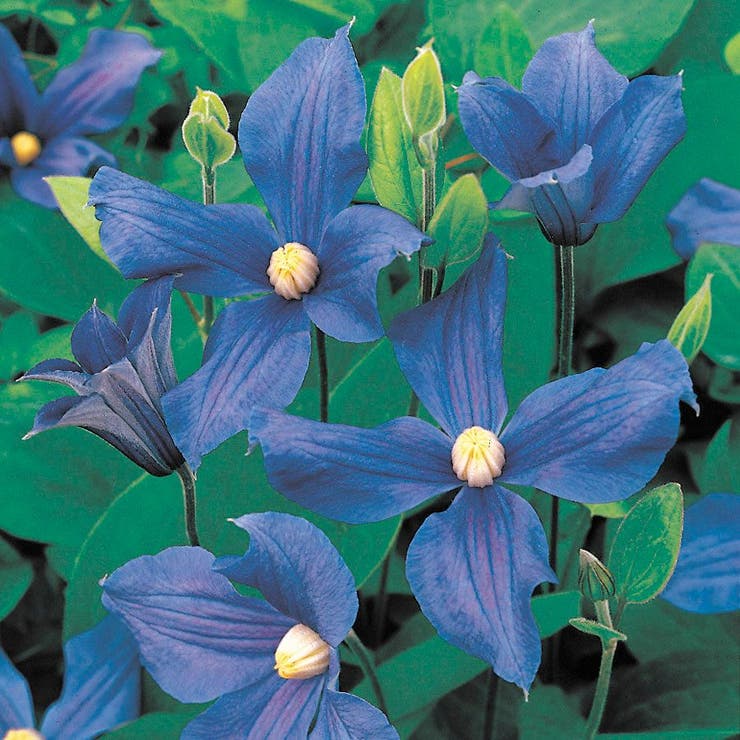
Dharaseeds
Clematis durandii Seeds
Estimated Free Delivery between April 16 and April 19.
Secured Payment Methods
Your transaction is protected with advanced security measures to keep your information confidential
Clematis Durandii is a striking variety known for its deep blue, star-shaped flowers and its ability to create a dramatic display in the garden. Native to China, this clematis is a favorite for adding both elegance and height to garden structures. Its vibrant blue blooms with yellow centers make it a standout, particularly in vertical gardens. Clematis Durandii Seeds are an excellent choice for gardeners looking to grow this stunning vine from seed and enjoy its beautiful flowers for many seasons.
Key Benefits
- Vibrant Blue Blooms: Known for its deep, intense blue flowers with contrasting yellow centers, making it a focal point in any garden.
- Long Blooming Period: Clematis Durandii typically blooms from late spring to early summer, offering months of vibrant flowers.
- Climbing Vine: Ideal for growing on trellises, fences, and arbors, it adds vertical interest to any garden.
- Low Maintenance: Once established, this variety requires minimal care, making it an easy and rewarding plant for gardeners of all skill levels.
- Pollinator-Friendly: The bright flowers attract bees, butterflies, and other pollinators to your garden, helping to support local biodiversity.
Variety Features
- Plant Characteristics: Clematis Durandii is a climbing vine with twining stems and a bushy growth habit. It produces dense foliage that complements its colorful blooms.
- Flower Size: Flowers are large and star-shaped, typically about 4–5 inches across, with a distinctive blue hue and a bright yellow center.
- Growth Habit: This variety is vigorous and can quickly cover structures, growing up to 8–12 feet tall.
- Height: Clematis Durandii can reach a height of 8–12 feet when fully established, making it perfect for vertical gardening.
Planting Instructions
Planting Season
- Start seeds indoors in early spring, about 6–8 weeks before the last expected frost. Once the danger of frost has passed, you can transplant seedlings outdoors.
- Direct sowing is also possible once the ground has warmed up, although starting indoors may increase your chances of success.
Planting Details
- Seed Depth: Plant clematis seeds about 1/8 inch deep in a moist, well-draining seed-starting mix.
- Spacing: Space seedlings about 12–18 inches apart to allow for healthy growth and air circulation.
- Soil Requirements: Prefers rich, well-drained, slightly alkaline soil with a pH of 6.0–8.0. Ensure the soil is fertile and can retain moisture while draining well.
- Sunlight: Clematis Durandii thrives in full sun, though it can tolerate partial shade. However, its flowers will be most vibrant in full sun.
Care Instructions
Watering
- Keep the soil consistently moist but not waterlogged, especially during germination. Once established, water deeply but infrequently to encourage strong root development.
- Water at the base of the plant to prevent moisture from accumulating on the foliage.
Fertilization
- Apply a balanced fertilizer (e.g., 10-10-10) in early spring to encourage strong growth and abundant blooms.
- Clematis Durandii is relatively low-maintenance, but a small boost of fertilizer in early summer can help support continued blooming.
Weeding and Mulching
- Regularly weed around the base to prevent competition for nutrients and moisture.
- Use mulch around the roots to keep them cool and retain moisture. Avoid placing mulch directly against the crown of the plant to prevent rot.
Pruning
- Clematis Durandii blooms on old wood, so pruning should be done after flowering. Remove dead or damaged stems and trim back any excess growth to maintain the plant’s shape.
- This clematis requires minimal pruning, but regular maintenance ensures a tidy appearance and continued blooming.
Pest and Disease Control
Pests
- Common pests for clematis include aphids, slugs, and snails. Use organic pest control methods like neem oil, insecticidal soap, or hand-picking pests.
- Regularly inspect the leaves and stems for signs of pest damage.
Diseases
- Clematis Durandii can be susceptible to powdery mildew and clematis wilt. Ensure proper air circulation by spacing plants well and avoid overhead watering to reduce the risk of fungal infections.
- Remove any infected plant material promptly to prevent the spread of disease.
Harvesting
Maturity
- Clematis Durandii typically reaches full maturity in 2–3 years from seed, although it may start flowering in the second year if grown from seedlings.
Harvesting Blooms
- Once flowers are fully open, you can cut the flower stems for floral arrangements. Ensure to use clean, sharp scissors to avoid damaging the plant.
Storage
Short-Term
- Fresh clematis flowers can last for up to a week in a vase with water, changing the water daily to maintain freshness.
Long-Term
- For longer storage, clematis flowers can be dried by hanging them upside down in a cool, dry, and dark location. Once dried, store the flowers in airtight containers to preserve their shape and color.
Culinary Uses
- Edible Flowers: Clematis flowers are not typically consumed, but their vibrant beauty can make them a stunning garnish or decoration for cakes and desserts. Always ensure that any flower you consume is non-toxic.
Conclusion
Clematis Durandii Seeds offer gardeners the opportunity to grow one of the most breathtaking clematis varieties from seed. With its vibrant blue blooms and yellow centers, this clematis is perfect for adding a burst of color to your vertical garden. Whether grown on trellises, arbors, or fences, Clematis Durandii creates a spectacular focal point. With minimal care and proper maintenance, your clematis vine will reward you with stunning flowers year after year, making it a valuable addition to any garden.










